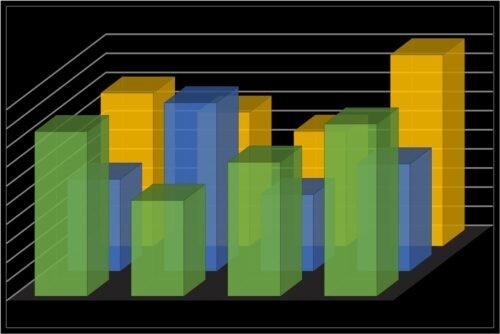In today’s rapidly changing business landscape, accurate forecasting has become more critical than ever. To stay ahead of the competition and make informed decisions, organizations must rely on reliable forecasting methods. One such approach is qualitative forecasting, which involves the use of subjective opinions and expert judgments to predict future outcomes. By taking into account factors such as market trends, customer preferences, and industry insights, qualitative forecasting methods provide invaluable insights into potential opportunities and challenges. This article explores the various techniques and advantages of qualitative forecasting, empowering you with the knowledge to make informed business predictions.
Introduction
Qualitative forecasting methods play a crucial role in predicting future trends, behaviors, and outcomes. Unlike quantitative forecasting methods that rely heavily on historical data and statistical models, qualitative methods emphasize subjective inputs and expert opinions. These methods are widely used in various industries and decision-making processes where data may be limited or unreliable. In this article, we will explore the definition of qualitative forecasting methods, their advantages, various types, and factors influencing their effectiveness. We will also compare qualitative methods with quantitative forecasting methods to understand their differences and applicability.
Definition of Qualitative Forecasting Methods
Qualitative forecasting methods refer to approaches that rely on subjective inputs, expert opinions, and judgments to predict future events or phenomena. These methods are based on the assumption that historical data and statistical models may not be sufficient to capture the complexities and uncertainties of the real world. Qualitative forecasting methods allow decision-makers to consider various qualitative factors, such as market trends, customer preferences, and expert opinions, in their forecasting processes. These methods provide flexibility and allow for adjustments based on changing circumstances.

Advantages of Qualitative Forecasting Methods
Flexibility
One major advantage of qualitative forecasting methods is their flexibility. Unlike quantitative methods that heavily rely on historical data and mathematical models, qualitative methods allow decision-makers to incorporate new information, insights, and changing circumstances into their forecasts. This flexibility is particularly valuable in dynamic environments where traditional quantitative forecasting methods may fall short. By considering qualitative inputs, decision-makers can adjust their forecasts in real-time and make better-informed decisions.
Expertise Utilization
Qualitative forecasting methods also leverage the expertise and knowledge of subject matter experts. These experts can provide valuable insights into market trends, industry dynamics, and consumer behavior that may not be captured by historical data alone. By tapping into their expertise, decision-makers can gain a deeper understanding of the factors influencing future outcomes and make more accurate forecasts. Expert opinions can also serve as a critical validation tool, especially in situations where traditional quantitative forecasting methods may yield conflicting results.
Types of Qualitative Forecasting Methods
Market Research
Market research is a popular qualitative forecasting method that involves gathering data and insights directly from potential customers or target markets. It aims to understand consumer preferences, needs, and trends through surveys, interviews, focus groups, and observational studies. Market research allows decision-makers to obtain firsthand information about consumers’ attitudes, behaviors, and purchasing patterns. By analyzing this data, decision-makers can make informed forecasts about market demand and trends.
Panel Consensus
Panel consensus is a qualitative forecasting method that involves assembling a group of experts or stakeholders to collectively make predictions or decisions. The panel members share their individual insights, opinions, and judgments, which are then deliberated upon to reach a consensus forecast. Panel consensus harnesses the collective wisdom and diverse perspectives of the participants to achieve a more accurate and robust forecast. This method is often used in situations where expert opinions play a significant role, such as investment decision-making or scenario planning.
Delphi Method
The Delphi method is a structured and iterative qualitative forecasting technique that seeks to achieve a consensus forecast through a series of questionnaires and feedback rounds. It involves a panel of experts who provide their individual forecasts anonymously. The forecasts are then aggregated, and a summary is presented to the panel members for further consideration. After multiple rounds of feedback and analysis, a consensus forecast is reached. The Delphi method allows for the elimination of biases and encourages independent thinking among experts, leading to more reliable forecasts.
Historical Analogy
The historical analogy method involves drawing insights and predictions by comparing current situations or events with similar past occurrences. Decision-makers identify historical events or situations that share similarities with the present scenario and use the outcomes or patterns from those past events to make forecasts. Historical analogy provides a reference point for decision-making and helps assess potential future outcomes based on past experiences. However, it is important to note that historical analogy is limited by the uniqueness of each situation, and the validity of the analogy depends on the similarity of key factors.

Market Research
Definition
Market research is a qualitative forecasting method that involves systematic data collection, analysis, and interpretation to gain insight into market trends, consumer behavior, and preferences. It provides decision-makers with valuable information about customers, competitors, and industry dynamics, enabling them to make informed predictions about future market conditions.
Process
The market research process begins with defining the research objectives and formulating research questions. These questions guide the data collection process and help in obtaining relevant information. The next step involves selecting appropriate data collection techniques, such as surveys, interviews, or observational studies. The collected data is then analyzed using various qualitative analysis techniques, such as thematic analysis or content analysis, to identify patterns, themes, and trends.
Data Collection Techniques
Market research utilizes a variety of data collection techniques to gather insights and information from target markets. Surveys are commonly used to collect large amounts of data from a wide range of respondents. Interviews allow for more in-depth and exploratory discussions, providing rich qualitative data. Focus groups bring together a small group of individuals to engage in interactive discussions and generate insights through group dynamics. Observational studies involve directly observing and recording consumer behavior in real-world settings. By using a combination of these techniques, market research ensures comprehensive data collection for accurate qualitative forecasting.
Panel Consensus
Definition
Panel consensus is a qualitative forecasting method that aims to achieve a collective agreement on future predictions or decisions among a group of experts or stakeholders. The method relies on the expertise and diverse perspectives of the panel members to generate a robust and reliable forecast.
Panel Creation
Creating an effective panel is crucial for a successful panel consensus forecast. Panel members should be selected based on their subject matter expertise, experience, and ability to contribute valuable insights. It is important to ensure diversity in the panel composition to capture a wide range of perspectives and reduce the risk of biases. The panel should also be of an appropriate size to facilitate effective communication and decision-making.
Deliberation Process
The panel deliberation process involves a series of discussions, exchanges of opinions, and debates among the panel members. Each member presents their individual forecasts or opinions, and these are deliberated upon to reach a consensus. The deliberation process should encourage open and respectful communication, allowing panel members to challenge and debate ideas constructively. The facilitator plays a crucial role in guiding the discussions, ensuring equal participation, and facilitating the convergence of opinions towards consensus.

Delphi Method
Definition
The Delphi method is a structured and iterative qualitative forecasting technique that aims to achieve a reliable consensus forecast by collecting and analyzing expert opinions anonymously. The method utilizes questionnaires and feedback rounds to gradually refine and converge opinions towards a consensus.
Procedure
The Delphi method begins with the selection of a panel of experts who provide their individual forecasts anonymously. Each expert responds to a series of questionnaires that are designed to gather their opinions and insights. After each round of questionnaires, the responses are aggregated, analyzed, and presented to the panel members without revealing individual identities. The experts then provide their revised forecasts based on the feedback received in the previous round. This iterative process continues until a consensus forecast is reached.
Advantages
The Delphi method offers several advantages in qualitative forecasting. By maintaining anonymity, it eliminates the influence of dominant personalities and hierarchy bias, encouraging independent thinking among experts. The structured and iterative nature of the Delphi method allows for the refinement and convergence of opinions over time, leading to more reliable forecasts. This method also enables experts from geographically dispersed locations to participate, facilitating a diverse range of perspectives and reducing geographical biases.
Historical Analogy
Definition
Historical analogy is a qualitative forecasting method that involves making predictions based on similarities between past events or situations and the current scenario. Decision-makers identify historical occurrences that share key similarities with the present and draw insights and predictions based on the outcomes or patterns observed in those past events.
Application
Historical analogy is commonly used in decision-making processes, such as strategic planning or risk assessment, where historical precedents can provide valuable insights. Decision-makers examine historical events that resemble the current situation and analyze the factors that influenced the outcomes. By identifying patterns and trends from the past, decision-makers can make informed forecasts and assess potential future scenarios.
Limitations
Despite its usefulness, historical analogy has limitations that decision-makers need to consider. Each situation is unique, and simply relying on historical precedent may not fully capture the complexities and specificities of the present scenario. The validity of the analogy depends on the similarity of key factors, and even small differences can lead to vastly different outcomes. It is important for decision-makers to exercise caution when applying historical analogy and consider other qualitative and quantitative inputs for a more comprehensive forecast.
Factors Influencing Qualitative Forecasting Methods
Subjectivity
One of the major factors influencing qualitative forecasting methods is subjectivity. These methods heavily rely on individual opinions, judgments, and interpretations, which can introduce biases and variations in forecasts. Different experts may have different perspectives or interpretations of the available information, leading to divergence in forecasts. Decision-makers need to be aware of subjectivity and take steps to minimize biases, such as using structured processes, anonymous feedback, or diverse panels, to ensure more accurate and reliable forecasts.
Availability of Data
The availability of data can significantly impact the effectiveness of qualitative forecasting methods. These methods rely on data collection techniques, such as market research or expert opinions, to gather information. If data is limited, incomplete, or unreliable, the accuracy of qualitative forecasts may be compromised. Decision-makers need to ensure that appropriate data collection processes are in place and that the data used in qualitative forecasting is accurate, relevant, and comprehensive.
Expertise
The expertise of individuals involved in the forecasting process is a critical factor influencing the effectiveness of qualitative forecasting methods. The selection of experts or panel members should be based on their knowledge, experience, and ability to contribute valuable insights. Diverse expertise ensures a comprehensive consideration of different perspectives and reduces the risk of biases. Decision-makers should also provide appropriate training and support to experts, enabling them to make informed judgments and forecasts.
Comparison with Quantitative Forecasting Methods
Differences
Qualitative forecasting methods differ from quantitative methods in several key aspects. Quantitative methods heavily rely on historical data and mathematical models to make predictions, while qualitative methods emphasize subjective inputs, expert opinions, and judgments. Quantitative methods aim for objectivity and precision, while qualitative methods embrace subjectivity and flexibility. Quantitative methods are more suitable for situations with reliable historical data and stable patterns, while qualitative methods are preferred when data is limited, unreliable, or dynamic.
Applicability
Qualitative forecasting methods are highly applicable in situations where quantitative methods may fall short. When historical data is limited or unreliable, qualitative methods can provide valuable insights by leveraging expert opinions and subjective inputs. Qualitative methods are also useful in dynamic environments where forecasts need to be adjusted in real-time based on changing circumstances. However, it is important to note that qualitative methods can be time-consuming and resource-intensive compared to quantitative methods, particularly for large-scale forecasting projects.
In conclusion Qualitative Forecasting Methods
Qualitative forecasting methods provide decision-makers with flexibility, expert insights, and the ability to make accurate predictions in dynamic or data-limited environments. Market research, panel consensus, Delphi method, and historical analogy are some of the common types of qualitative forecasting methods. However, it is essential to consider factors such as subjectivity, availability of data, and expertise to ensure the effectiveness and reliability of qualitative forecasts. While qualitative methods differ from quantitative methods in terms of approach and applicability, they play a vital role in decision-making processes where subjective inputs and expert opinions are crucial for accurate predictions.
FAQ:
Q1: What are the 4 forecasting methods?
The four forecasting methods are qualitative, time series, causal, and simulation.
Q2: What are the 5 qualitative methods of sales forecasting?
The five qualitative methods include expert judgment, Delphi method, market research, historical analogy, and panel consensus.
Q3: What is the Delphi method of qualitative forecasting?
The Delphi method is a structured communication technique involving experts to gather and refine insights for forecasting.
Q4: Which is a quantitative forecasting method?
Time series is a quantitative forecasting method that analyzes historical data to predict future values.
Q5: What are the 2 main methods of forecasting?
The two main methods of forecasting are qualitative and quantitative.
Q6: What is the most accurate forecasting method?
Accuracy depends on the context, but combining both qualitative and quantitative methods often enhances accuracy.
Q7: Is Delphi qualitative or quantitative?
Delphi is a qualitative method, relying on expert judgment and consensus.
Q8: What are qualitative and judgmental forecasting techniques?
Qualitative and judgmental forecasting involves expert opinions, intuition, and subjective insights.
Q9: What is the difference between qualitative and quantitative forecasting?
Qualitative relies on subjective insights, while quantitative involves numerical data and statistical models.
Q10: What are the three types of forecasting?
The three types of forecasting are short-range, medium-range, and long-range.
Q11: Can forecast methods be qualitative or quantitative?
Yes, forecast methods can be either qualitative or quantitative, depending on the approach used.
Q12: What is time series forecasting methods?
Time series forecasting methods analyze historical data to predict future values based on patterns and trends.
Q13: What is the simplest forecasting method?
The simplest forecasting method is often the naive approach, where the forecast is based on the last observed value.
Q14: Which is the #1 rule of forecasting?
The #1 rule of forecasting is to consider both quantitative and qualitative factors for a comprehensive analysis.
Q15: Which of the following is not a qualitative forecasting technique?
Time series is not a qualitative forecasting technique; it falls under the quantitative category.
Q16: What is an example of a quantitative forecasting?
Regression analysis is an example of a quantitative forecasting method.
Q17: How to do forecasting in Excel?
In Excel, use functions like FORECAST or build custom models for quantitative forecasting.
Q18: What is a good example of forecasting?
Predicting future sales based on market trends is a good example of forecasting.
Q19: What is the best model for time series forecasting?
The best model for time series forecasting depends on the data characteristics, with ARIMA and Exponential Smoothing being common choices.
Q20: Which forecasting is best for time series?
Time series forecasting methods, such as ARIMA, are best suited for predicting values in a sequential order.
Q21: Is time horizon a forecasting technique?
No, time horizon is not a forecasting technique; it refers to the planning period for which forecasts are made.
